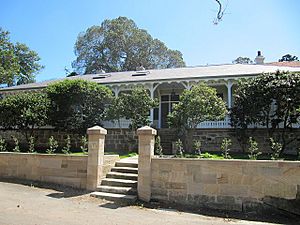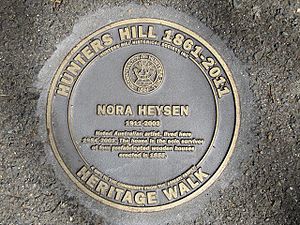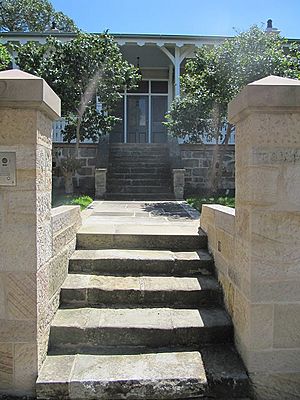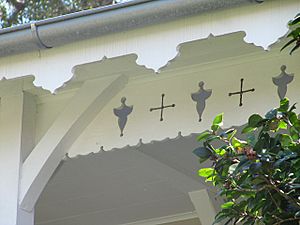The Chalet facts for kids
Quick facts for kids The Chalet |
|
|---|---|
 |
|
| Location | 2 Yerton Avenue, Hunters Hill, Municipality of Hunter's Hill, New South Wales, Australia |
| Built | 1855 |
| Architectural style(s) | Victorian |
| Official name: The Chalet; The Bungalow (1867); The Nora Heysen Studio | |
| Type | State heritage (built) |
| Designated | 10 June 2005 |
| Reference no. | 1727 |
| Type | Other - Residential Buildings (private) |
| Category | Residential buildings (private) |
| Builders | Assembled by German carpenters:
|
| Lua error in Module:Location_map at line 420: attempt to index field 'wikibase' (a nil value). | |
The Chalet is a special house in Hunters Hill, Australia. It is listed on the heritage register because it is very old and important. This house was built in 1855. It was put together by three German carpenters: Willhelm Gross, Frederick Lemm, and Jacob Arndt. The Chalet is also known as The Bungalow and The Nora Heysen Studio. It is a private home that was added to the New South Wales State Heritage Register in 2005.
Contents
History of The Chalet
First People of the Land
Long ago, the land where The Chalet stands was home to the Wal Umedegal Clan. They spoke the Guringai language. These First People lived by fishing and gathering shellfish. They also ate vegetables, small animals, birds, and grubs. They often used fire to clear the land. This helped them reach the river and find food. We do not know much about their social life or beliefs.
Early European Settlers
In 1788, Captain John Hunter explored Sydney Harbour. He made detailed maps of the area. Hunter later became the Governor of the colony from 1795 to 1800. Hunters Hill is named after him.
How The Chalet Was Built
The Chalet is the only one left of four special "Swiss Cottages." These houses were built in a factory in Hamburg, Germany. Then, they were shipped to Sydney in 1854 or 1855. A Swiss person named Etienne-Jean-Leonard Bordier-Roman brought them to Australia. He wanted to sell them as homes.
These houses were built during the gold rush. Many workers left their jobs to search for gold. This made it hard to find builders. So, bringing in ready-made houses and skilled workers from overseas was a good idea. Bordier hired three German carpenters to put the houses together. He even paid for their trip to Australia. This made sure they would finish the work.
The houses were set up on land Bordier bought in Hunters Hill. This area became a French community. Many early buildings there were made by people from France. Hunters Hill became known as Australia's oldest "Garden Suburb." This means it was planned with lots of green spaces and gardens.
Over time, the other three houses were taken down. The Chalet was the only one that remained. It changed owners several times. In 1867, it was named "The Bungalow." Later, it was called "Yerton." The street where it stands, Yerton Avenue, is named after the house.
Nora Heysen's Home
In 1954, the famous artist Nora Heysen bought The Chalet with her husband, Robert Black. Nora Heysen was a very important Australian painter. She was the first woman to win the Archibald Prize for portraits in 1938. She was also Australia's first woman war artist during World War II.
Nora loved The Chalet and its garden. She said it was a peaceful place that helped her work. She often painted flowers from her garden on the back verandah. She grew many kinds of flowers, like roses, jonquils, and anemones. She lived and worked in The Chalet until she passed away in 2003.
The Chalet is very special because it is one of the few prefabricated houses from the 1850s left in Australia. It shows how people built homes during the gold rush when materials and workers were scarce.
What The Chalet Looks Like
The Garden
The garden surrounds The Chalet on three sides. It has wide sandstone steps that lead from the street to the house. The front garden is full of bushy plants.
The back verandah of the house is level with the lawn. Nora Heysen loved to work here. She would paint, drink coffee, and feed the magpies. She often painted flowers from her garden, especially roses. She also grew many other cottage garden flowers. These included snowdrops, daffodils, and zinnias. She even had a special bed of anemones, which were her mother's favorite.
The garden has a huge Moreton Bay fig tree and a beautiful jacaranda tree. These trees provide shade and attract birds. The garden also has many other interesting plants, like camellias, citrus trees, and bamboo.
The House Itself
The Chalet is a single-story house made from Baltic timber. It sits on sandstone foundations and has a hipped slate roof. It has a wide front verandah with fancy wooden trim, called fretwork. From here, you can see the Parramatta River. The back of the house also has a paved verandah. Many French doors open onto the front verandah.
The house was designed to look like a "Swiss Cottage." These types of houses were popular in Europe. The timber pieces of the house were numbered, like a kit, to make them easier to put together. This was a common way to build prefabricated homes. The verandah has a special design that protects the roof timbers from water.
Inside, the dining room has a cozy fireplace. During Nora Heysen's time, it was filled with art and interesting objects. She had carvings from New Guinea and bowls of fruit. Her studio was full of her paintings. There is also a small sandstone building in the garden with a corrugated iron roof.
Why The Chalet Is Important
The Chalet is very special for many reasons:
- It is a very rare example of an early prefabricated timber house in Australia. It was imported from Germany in 1855.
- It is the only one left of four similar houses that were built in Hunters Hill.
- It shows how people solved the housing shortage during the 1850s gold rush by importing ready-made buildings.
- It is a beautiful example of a "Swiss" or "Bavarian" style cottage from the Victorian period. It has many original decorative details.
- It is important because of its connection to the famous Australian artist Nora Heysen. She lived and worked there for almost 50 years. Her garden and home inspired many of her paintings.
- The house and its garden show the beginning of the "Garden Suburb" idea in Australia. Hunters Hill was one of the first places planned with this idea.
- It helps us understand how imported "knock-down" houses were built during the gold rush. It also shows the skill of the German carpenters who put it together.
The Chalet was listed on the New South Wales State Heritage Register in 2005. This means it is protected and recognized as an important part of history.
Images for kids





